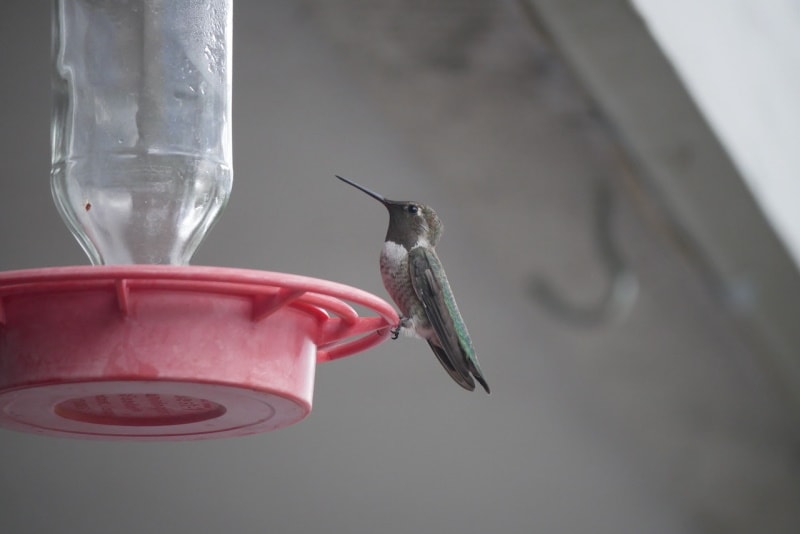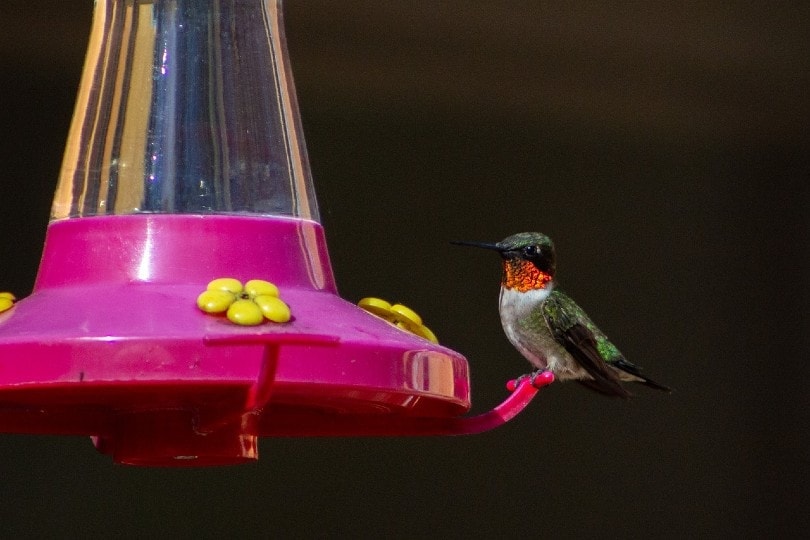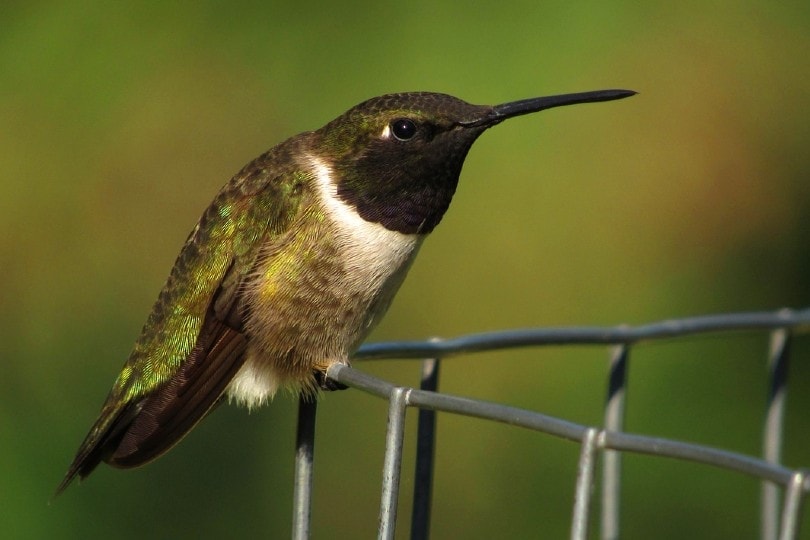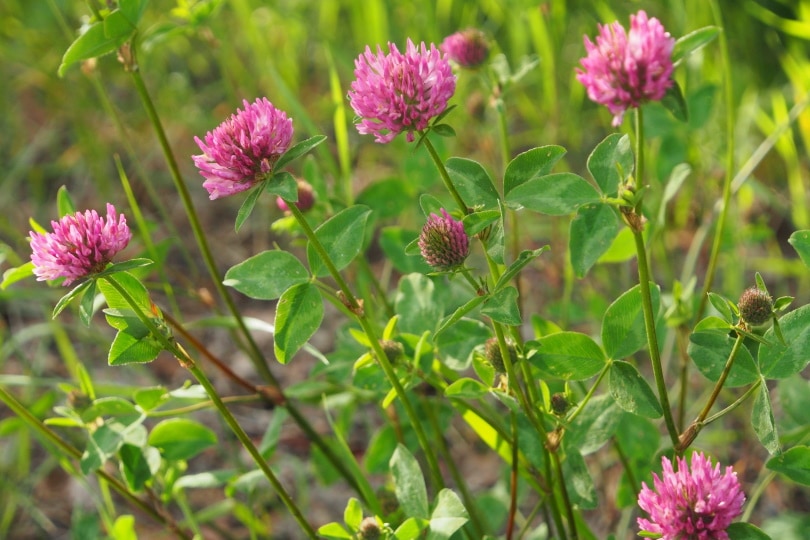2 Types of Hummingbirds in Oklahoma (with Pictures)
Last Updated on

Hummingbirds are wonderful pollinators and without a doubt one of the most welcomed species of bird when the weather begins to warm. While there are over 300 species of hummingbirds, only two of those migrate up into Oklahoma during the season.
In this article, we are going to take a closer look at these two species and what makes them unique. We will also provide some tips on attracting these incredible, speedy little birds into your yard.

Top 2 Types of Hummingbirds in Oklahoma:
1. Ruby-throated Hummingbird

| Scientific Name: | Archilochus colubris |
| Weight: | 0.071 – 0.212 ounces |
| Length: | 3 – 3.5 inches |
| Wingspan: | 3.1 – 4.3 inches |
The Ruby-throated hummingbird is the most common species of hummingbird found east of the Great Plains. They are also the most common species in Oklahoma, though they are much more concentrated in the eastern portion of the state.
Ruby-throated hummingbirds spend their winters in Central America, including Mexico, Costa Rica, and Panama. They migrate north into North America in the spring, with males typically heading north before the females.
Their diet consists of insects and nectar, and they have a special affinity for tubular flowers. This species gets its name from the distinct iridescent red throats of the males. Both sexes display beautiful emerald-green feathers on the back and the crown.
Ruby-throated hummingbirds will often visit yards that are full of flowers and insects. They can easily be drawn in with hummingbird feeders and are a welcomed sight by many in the East and Midwestern United States as it means that spring has finally arrived.
2. Black-chinned Hummingbird

| Scientific Name: | Archilochus alexandri |
| Weight: | 0.1 – 0.2 ounces |
| Length: | 3 – 4 inches |
| Wingspan: | 4 – 4.5 inches |
The Black-chinned hummingbird is not nearly as common as the Ruby-throated hummingbird. During their breeding season, they can be seen in the southwestern portion of Oklahoma but are much more common across the western states at lower elevations during this time.
These migratory birds will arrive in the spring and leave when fall comes around and they make their way to Mexico for the winter. Unlike some other western hummingbirds that may stick around for winters in the states with warmer climates, the Black-chinned is typically nowhere to be seen.
Like other hummingbirds, their diet consists mainly of nectar and insects. They are often seen in backyards and gardens and will frequent hummingbird feeders.
Male, Black-chinned hummingbirds are identified by their black throats with an iridescent purple coloration at the vase. This species has longer wings that either reach the tip of the tail or very slightly beyond.

Tips for Attracting Oklahoma Hummingbirds
Many people enjoy sitting back and observing these unique, tiny birds. For those that wish to host hummingbirds when they make their way into Oklahoma, we’ve provided some tips for attracting them into your yard for your viewing pleasure.

Plant Lots of Flowers
One of the best ways to attract hummingbirds into your yard is by providing them with their favorite food source, flowers. Hummingbirds seem to be drawn to certain colors like red, orange, deep pink, and deep yellow and are certainly partial to tubular flowers. Planting lots of colorful flowers will not only enhance your landscape but will make it much more likely for you to get visitors in the springtime.
Hang Hummingbird Feeders
One of the most popular ways to make your yard hummingbird-friendly is by hanging hummingbird feeders. This will allow you to hang it in an area that gives you the best view of these beautiful birds.
When you hang a feeder, make sure to hang it high enough that predators cannot reach the birds when they come to feed. It’s recommended that you avoid the store-bought nectars that contain potentially harmful red dye, sugar water will work just fine.

Provide Water Sources
Like all other birds, hummingbirds require a water source that is separate from their nectar. Since hummingbirds can drink mid-air, you can try using a misting bird bath for your yard but you can also opt for a regular bird bath too, just make sure to keep the water clean and fresh.
Make Sure There Are Places to Perch
Hummingbirds will need perches to rest when they are not actively in flight. Research suggests that they spend up to 80 percent of their time perching, so it makes sense to have some perches available in your yard if you’d like them to pay you regular visits.
Having a variety of perches in both the sun and shade will help. Natural perches like shrubs and branches are best but you can also buy some artificial perches and place them in areas that give you the best view. They will also use patio furniture and other objects.

Display Vibrant Colors in Your Yard
As mentioned, hummingbirds seem to be attracted to bright, vibrant colors. This is because they have a heightened sensitivity to both the red and yellow ends of the color spectrum. Humans only have three types of color-sensitive cones within the eye while hummingbirds have a fourth, which makes them sensitive to ultraviolet light.
Putting bright, vibrant colors like red throughout your yard may help attract them. You may have noticed that most hummingbird feeders are red for this very reason. You can also plant lots of colorful flowers and display colorful yard décor.
Grow Hummingbird-Friendly Plants
A great way to attract any bird into your yard is by planting their favorite plants in your yard. Not only do certain flowers provide them with their main food source, nectar but they will also attract another primary food source, insects.
Some of the best flowers to grow are trumpet creepers, salvia, cardinal flowers, bleeding hearts, petunias, lupine, and zinnias. We’ve talked about how hummingbirds like to perch and rest, so having perch-friendly plants in the yard will also help you attract them.

Keep Feeders Clean
Not only is it very important to keep your hummingbird feeders clean for the safety of the birds, but it is also necessary to keep them coming back. It’s recommended to clean them thoroughly twice a week during warmer weather and once a week when it’s cooler to prevent contamination. This will also help deter ants and other pests that will gravitate toward the sweet nectar in the feeder.
Deter Ants
When hummingbird season comes around, so do the ants. It’s common for ants to become a nuisance, especially around the hummingbird feeders that are filled with sugar water. Keep a close eye on your feeder to make sure it doesn’t get overrun with ants. Make sure the feeder stays clean and even look into some natural ant deterrents. Hanging the feeder with a fishing line is also a great way to deter pesky insects.

Final Thoughts
While there may be plenty of species of hummingbirds that make their way into the United States during the spring and summer, only two species are seen in the state of Oklahoma: The Ruby-throated hummingbird and the Black-chinned hummingbird.
The Ruby-throated hummingbird is the most observed species within the state and is widespread east of the Great Plains. The Black-chinned hummingbird is much rarer and only makes its way into the southwestern corner of the Sooner State.
The good news is that there are plenty of ways to attract these fast-paced beauties into your yard when the season hits.
Featured Image Credit: Connor kane, Pexels
About the Author Robert Sparks
Robert’s obsession with all things optical started early in life, when his optician father would bring home prototypes for Robert to play with. Nowadays, Robert is dedicated to helping others find the right optics for their needs. His hobbies include astronomy, astrophysics, and model building. Originally from Newark, NJ, he resides in Santa Fe, New Mexico, where the nighttime skies are filled with glittering stars.
Related Articles:
Monocular vs Telescope: Differences Explained (With Pictures)
10 Types of Hummingbirds in Arkansas (With Pictures)
8 Types of Hummingbirds in Nebraska (With Pictures)
5 Types of Hummingbirds in Idaho (With Pictures)
3 Types of Hummingbirds in Mississippi (With Pictures)
8 Types of Hummingbirds in Kansas (With Pictures)
5 Types of Hummingbirds in West Virginia (With Pictures)
5 Types of Hummingbirds in Ohio (With Pictures)
